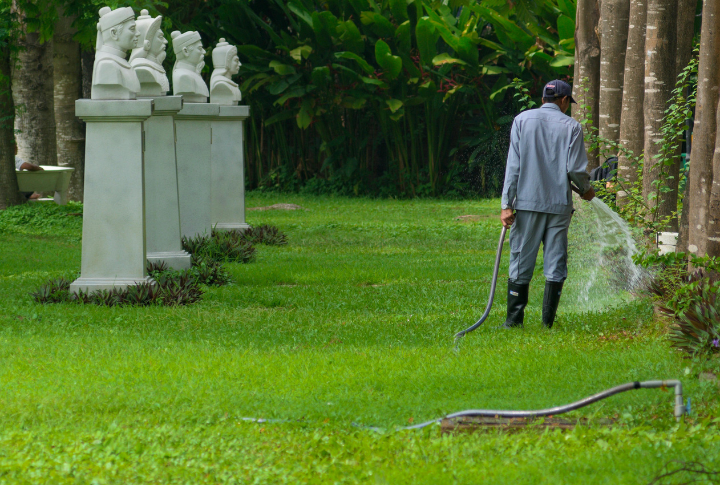
Timing is everything when it comes to taking care of your lawn. If you water at the wrong time, you might end up with dry spots, fungus, or even rotting roots. By learning the best times to water, you can have a beautiful green yard while saving water and helping the environment.
Watering in the Afternoon

It might seem convenient to water your lawn during the afternoon heat, but that’s one of the worst times. The high temperatures cause rapid evaporation, and most of the water won’t reach the roots. You’ll end up wasting water without giving your lawn the hydration it needs.
Why Late Evening Watering Is Risky

Watering your lawn after sunset might sound relaxing, but it’s not suitable for your grass. With cooler evening temperatures, water tends to sit on the grass overnight, increasing the chance of fungal growth and disease. Your lawn needs time to dry so it won’t get dark.
The Downside of Morning Showers

Although early morning is one of the best times to water, doing it too late in the morning isn’t ideal either. By mid-morning, temperatures rise, leading to quick evaporation. Watering around 10 a.m. or later can make it harder for your grass to fully absorb the moisture it needs.
Avoid Mowing Before Watering

Many think watering before mowing is bright, but wet grass is tougher to cut. Mowing wet grass can lead to uneven cuts and may even damage your mower. Instead, water after mowing to let your lawn heal and absorb the hydration it requires to thrive.
The Problem with Watering in Strong Winds

Watering on a windy day? Don’t be surprised if the water blows away before it hits your lawn. Not only will the wind scatter your water, but your grass won’t even be soaked evenly. Save your water and your grass by choosing a calmer time to hydrate your lawn.
Rainy Days Aren’t Lawn Watering Days

Watering your lawn right before or after a rainstorm is a waste. Too much water can overwhelm your lawn and lead to root rot or soggy patches. On rainy days, let nature take care of the job, and wait a day or two before you water again to let things dry out.
The Perils of Watering in the Snow

Some think watering is necessary even during winter. But watering your lawn in freezing conditions is pointless. The water will freeze, potentially harming the grass and its roots. Snowfall provides enough moisture for most winter lawns, so let nature do its thing.
The Problem with Frequent Watering

Frequent watering might seem like a good idea, but your lawn benefits more from occasional, deeper soaks. Frequent, shallow watering encourages weak roots that can’t handle heat or drought. Watering less often but for longer will give your grass stronger roots.
Timing Your Watering Right

The golden rule for watering your lawn is early morning. This is when temperatures are cooler, and the sun isn’t too harsh, giving the water time to soak in without rapid evaporation. Watering earlier than 10 a.m. allows your lawn to absorb the moisture it requires while conserving water efficiently.
Watering in Hot Summer

In the hot summer, your grass needs more water to stay alive. The sun can dry it out fast, so give it extra drinks. Water your lawn deeply so the roots can reach the water. By watching the warm weather, you can make sure your grass stays strong and green.
Watering Various Types of Lawns

The duration and care required for different lawn types depend on the season, your location, and the specific grass variety you have. Each type of grass has unique watering and care requirements, so make it a point to recognize what kind of lawn you’re maintaining.
Neglecting the Needs of Your Grass

It’s essential to consider the age of your lawn. More mature grass can withstand a stronger spray, while newly seeded areas require a mild approach. For small patches of new seeds, a Stationary Square Sprinkler is great for easy watering, while for larger spaces, an Adjustable-Length Wind-Resistant Rectangular Sprinkler is a better option.
Skipping Over Watering Timers

If you’re using an automatic watering system, not setting a proper schedule can lead to watering at the worst times. Without a timer, your system may turn on in the heat of the day or during rainy periods. A well-planned schedule can save water and keep your grass healthy.
Best Watering Routine

To keep your lawn in good shape, aim to water for 20 minutes three times weekly. This works best with healthy, prepared soil that holds water at the roots and drains well. Inferior soil may either hold too much water, causing sogginess, or drain too quickly, leaving the ground too dry.
How to Determine if Your Lawn is Well-Watered

There are easy ways to check if your lawn is well-watered. The most common and apparent way is to observe its appearance. If it looks green and healthy, it’s likely receiving the right amount of water. If the lawn looks dry or patchy, it may be time to water more regularly.

